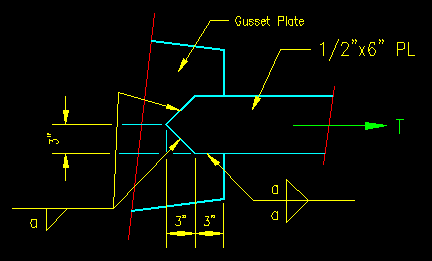|
|
Section 5.8.3
Example Problem 5.3
Last Revised: 05/30/2023
The example problems presented in this section have a spreadsheet solution. You will need this file to follow along with the presented solutions. You can click on the following link to get the file:
Chapter 5: Excel Spreadsheet Solutions
In addition to the spreadsheet solution this problem also has a downloadable hand solution: Example5_3.pdf
Example Problem 5.3: This example illustrates the application of the allowed increase in Fw for when the load is not parallel to weld axis as discussed in section 5.5.
Given: The connection shown has a flat plate tension member attached to a gusset plate as shown in Figure 5.8.3.1. The plates are A36 steel. The electrode is F6. The weld size a = 3/8”.
Figure 5.8.3.1
Angled Weld Connection
Click on image for larger view
Wanted:
a) Determine the weld strength of the connection considering the effect of
the angle of load to weld axis.
b) Determine the weld strength of the connection not considering the effect of
angle of load to weld axis.
c) Determine the thickness of the gusset plate to prevent shear rupture.
Solution:
In the interest of speed and simplicity, some engineers have been known to conservatively neglect the effect of the angle of the load relative to the axis of the filet weld when computing the capacity of weld groups similar to the one given in this problem. Indeed, we did ignore this in example problem 5.2, where the end weld's axis was perpendicular to the load direction. Consequently, this example has been given to contrast the difference in capacities when the angle is considered and when it is not.
A reminder: There are basic criteria that must be met in order to use the increase associated with angle of load direction to axis of weld. You can read about it in BGSCM 5.5.
For this weld group, we have a total of six inches where the load direction is parallel to the weld and 8.48 inches of weld where the angle is 45 degrees.
Computing kds using SCM equation J2-5, we find that the angled portion of the weld is significantly stronger than in the parallel part of the weld. Indeed, comparing the results of parts (a) and (b) we find that the capacity of the weld is 17.4% larger than what the conservative approach gives.
Finally, in this problem, we look to size the gusset plate to prevent shear rupture of the plate. In this case we want the weld to be the controlling strength. So, in effect, we are looking for the largest effective plate thickness.
In this situation, we look at a unit length of weld and base metal. We set the strength expressions equal to each other and solve for the plate thickness. Anything thinner than this value will cause the capacity of the connection to be controlled by shear rupture in the gusset plate. Anything larger will cause the capacity of the connection to be controlled by the strength of the fillet weld.
